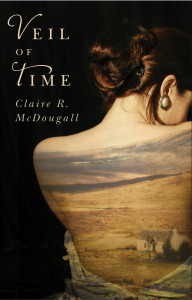Parting the Veil of Time
by Lucinda Byatt
Claire McDougall speaks with Lucinda Byatt.
Claire McDougall now lives in Colorado, but her first historical novel is set in Scotland, or more precisely in Argyll, where she grew up. Her family lived three miles away from Dunadd, a rocky prominence that was the stronghold of Dalriada, the kingdom of the Scotti. “When my family had guests, we would take them up Dunadd to see the boar in the rock and the famous imprint of the foot. Kilmartin valley where I lived is full of standing stones and rock art, and you can hardly help but feel the presence of all this history around you.” Then, about twenty years ago, she started to visit a childhood friend who had bought the cottage at the base of Dunadd, the same one that her character Maggie stays in. “I would climb up to the top of Dunadd in the evenings. The view over the sea from up there is astounding with the sun going down behind the Isle of Jura.”
In Veil of Time, Maggie lives in the present-day but she “slips” back in time to a crucial moment in the history of Dalriada, when their enemies, the Picts, are gathering strength in the north. Time-slip is a device that appeals to both reader and author: “It is a more accurate way of looking at what happens to Maggie. I had the idea of writing about Dunadd for quite a few years, but I couldn’t think of a way to do it. I knew the story would have to take place in the eighth century, Dunadd’s heyday, but very little is known about that era, so I didn’t think I would have enough material to sustain it for the length of a novel. In addition, I have always liked the notion of going back in time. I had never written anything like that, though, and I resisted for quite some time. However, I wanted a modern-day protagonist that I could relate to more closely. The more theoretical physicists delve into the notion of time, the less of a stretch this notion of time-slipping is becoming.”
The role of the ban-druidhe is central to the story. These druidesses were immensely influential in Gaelic society prior to the arrival of Christianity. Maggie becomes Ma-Khee to those she meets at Dunadd and they view her as foreign druidess. But Ma-Khee finds it hard to accept some of their strange ways. “Different customs meant that people’s mindset would have to be different from ours with regard to love, relationships and fidelity.” Researching this “woman-led culture” posed problems: “We do know that the royal line was matrilineal, and we do know that the indigenous pagan religion was goddess-centred. Once I had established this, and I started thinking about what would become of the druidesses, I could see that a few hundred years down the line the opposition of the church to these women would manifest itself in the witch burnings.” For more clues, the author turned to other indigenous peoples. “In many native American peoples, women make up the council for the important decisions of the tribe, while the men hold positions with more outward prestige. This balance seems to work well, as long as the wise women are not ousted, which is what happened once Christianity took hold. Matriarchal societies are more about cooperation and nurturing.”
The male characters offer a contrast: Fergus, a prince of Dalriada, is fascinated by Ma-Khee but wary of her otherness; Jim, an older man who is Maggie’s neighbour at the farm, is a wry Scotsman, who provides an important anchor at a very difficult time in Maggie’s life. Yet, Claire did not find it easy to write about the people of Dalriada: “The more I wrote, the more it seemed to me that theirs was a whole different way of looking at things. Getting into Fergus’s head and heart was hard, but I hope I managed to convey him to the reader in the end.” I think she did and, what’s more, a sequel, Druid Hill, has already been written. It takes place in the years following 735 CE and focuses on the druidess-monk conflict, and on what was lost when the Christian worldview took over.
An endearing detail is the presence of Winnie, a black kitten who befriends Maggie at Dunadd and follows her back in time. Winnie survives to be included in the sequel, too. And, on a bizarre note, Claire told me that a black cat was an uninvited guest at her book launch.
More about Veil of Time (Simon & Schuster’s Gallery Books, 2014). and Claire McDougall can be found at http://clairemcdougall.com
About the contributor: Lucinda Byatt is the Features Coordinator for HNR and also has family in Argyll, so she knows Dunadd well!
______________________________________________
Published in Historical Novels Review | Issue 68, May 2014







